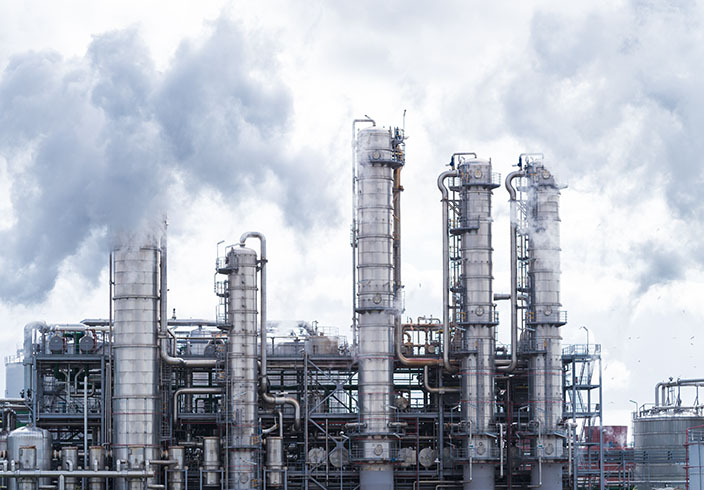Increase energy efficiency, reduce costs, and improve your own climate footprint: The avoidance and use of industrial waste heat holds great potential for companies. After all, heat is generated in practically every industrial process. Surplus heat can be used directly for downstream processes at lower temperature levels. Indirect use through appropriate processes is also possible. In this case, the waste heat is converted into electricity or upgraded by using efficient heat pumps and fed back into high-temperature processes. The crux: In practice, waste heat utilization has simply not been economical or interesting enough for many industrial companies to date, because networks and potential customers are lacking. The waste heat remains unused. This harms the environment, and a great deal of economic potential is lost.
Why is the use of waste heat in industry important?
And this, despite the fact that the opportunities are well known. “By collecting the waste heat from both industry and electricity production and using smart district heating grids, it is possible to save all of the natural gas currently used for heating buildings in Europe. This would result in not only monetary savings, but also in a considerable CO2 emissions reduction,” as Heat Roadmap Europe points out.
Resource efficiency and cost reduction
Making sensible use of the company’s own waste heat would therefore lead to significantly higher resource efficiency on the one hand. Secondly, costs would decrease if less budget had to be used for energy procurement. The German Energy Agency (DENA) states that companies could reduce energy consumption and energy costs for heat generation by up to 60 percent through the targeted use of waste heat. In doing so, DENA cites other benefits: “In addition to falling energy costs, companies achieve increased product quality, less wear and tear, greater occupational safety – and thus greater overall production efficiency – by modernizing their waste heat processes.” DENA points out that the returns on waste heat utilization measures are generally in the double-digit percentage range.
Climate protection through energy savings and CO2 reduction
According to estimates by the German Energy Agency, the potential savings from energy-efficient waste heat utilization for companies in Germany are around 5 billion euros a year. At the same time, it makes an important contribution to climate and environmental protection, since the targeted use of waste heat means that less energy is required overall. This can also significantly reduce CO2 emissions. According to calculations by Heat Roadmap Europe, the use of waste heat can lower CO2 emissions by 86% annually.
Challenges and solutions for industries in waste heat utilization
However, according to studies on waste heat recycling, about half of the companies surveyed do not use their waste heat at all. As stated by the authors, there are several reasons for this. For example, waste heat flows are often not warm enough to be reused directly in a new process. The waste heat must first be raised to a higher temperature level. A heat pump, for example, could provide a remedy. Furthermore, waste heat flow does not always coincide with a corresponding heat demand elsewhere. To be able to use waste heat technically, heat storage systems are therefore needed in industry that allow it to be used at different times.
Example ThermalBattery™ for a successful use of waste heat
The ThermalBattery™ from ENERGYNEST represents such a solution. The solid-state storage unit, which is comparatively easy to integrate into existing industrial processes, absorbs waste heat and returns it to the cycle. By connecting the ThermalBattery™ to industrial plants, heat that would otherwise be wasted can now be recovered and converted into process heat, steam or compressed air. This not only improves plant efficiency and decarbonization effectiveness, but also security of supply.
The ThermalBattery™ can also be charged cheaply with renewably generated energy at off-peak times. This energy is then stored inside the battery in a special concrete called HEATCRETE® until it is flexibly released again later in the form of heat or steam.
Economic aspects and investment costs
In energy-intensive industries in particular, the waste heat generated often exceeds the company’s own requirements, explains the German Federal Ministry for Economic Affairs and Climate Protection (BMWK). A sensible use in one’s own business would then not be possible. Instead, however, it may well be economically prudent to supply the waste heat to third parties and thus make the heat supply there more efficient.
“Net zero emissions in Europe is certainly achievable technically and economically. It does however require political changes in regulation. Our research shows that we need more than 21.500 new district heating systems in Europe and a massive billion-euro investment in better buildings until 2050,” says Brian Vad Mathiesen, Professor in Energy Planning and Renewable Energy Systems, Aalborg University. So the EU and local authorities in every country are called upon to create and make attractive incentives for industrial companies to recycle their waste heat and, if necessary, to use it sensibly outside their own companies by providing the appropriate regulatory and political framework and subsidies.
Using waste heat: Future prospects
If waste heat from industrial operations is used, experts see high economic and climate policy potential. According to DENA, in addition to in-house use of waste heat for power and cooling generation as well as space heating and hot water generation, enough waste heat above approx. 90 °C can also be fed into the local or district heating network or supply neighboring companies. However, the appropriate infrastructure must be available for this.
In practice, thermal storage solutions such as ThermalBattery™ quickly payoff: By supplying production cycles with recovered energy as needed, energy security is optimized while energy consumption, costs and carbon footprint are reduced.
Are you interested in ENERGYNEST, or have any questions regarding our thermal energy storage solutions or our applications for your specific industry?
Don’t hesitate to drop us a line.



